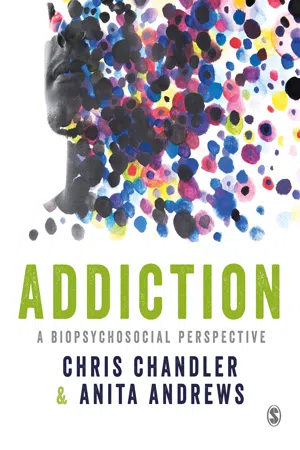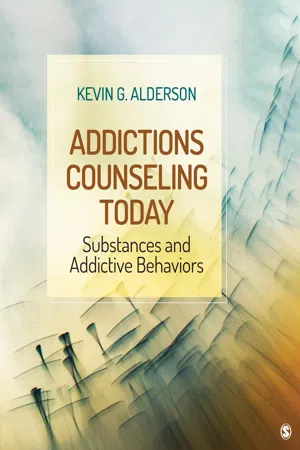Psychology
The Absorption Addiction Model
The Absorption Addiction Model suggests that some individuals have a tendency to become excessively absorbed in certain activities or experiences, leading to a kind of addiction to absorption. This absorption can provide a temporary escape from reality and may be linked to certain personality traits and psychological needs. The model highlights the potential impact of absorption addiction on mental health and well-being.
Written by Perlego with AI-assistance
Related key terms
5 Key excerpts on "The Absorption Addiction Model"
- eBook - ePub
- Mary McMurran(Author)
- 2003(Publication Date)
- Routledge(Publisher)
continuum of levels of involvement and the individual will slide up and down that continuum depending upon the current situation and his or her skills for coping with that situation. For example, many people will drift in and out of problematic substance use consequent upon finding or losing jobs, being in a stable relationship or breaking up from their partner, and having good living accommodation or finding themselves without a home.There Is No Cut-off Point for Addiction
The theories presented here do not present us with a cut-off point for addiction. It is acknowledged that people may have problems at any level of consumption, and that these problems may be interpersonal, legal, financial, scholastic, work-related, psychological or physical. There is no absolute cut-off point for addiction at which we may place our level of concern, as the disease model seems to suggest. That is, anyone who is experiencing problems in relation to substance use may be a candidate for help, and we need not label this person an ‘alcoholic’ or an ‘addict’ in order to make him or her eligible for our attention.Addiction Is Not Irreversible
None of the processes suggested by these psychological theories is irreversible. That is, we have moved away from the notion of addiction as a progressive and irreversible disease process. Clearly this has implications for interventions to reduce substance use. Using psychological theories, we can come up with a whole range of possible goals and interventions. First of all, we do not have to advocate abstinence in every case; for some people a reduction in substance use will be sufficient, and for others it may be more pressing to teach methods of harm reduction. This latter point is important these days when considering HIV transmission through the sharing of needles by intravenous drug users; it is crucial and urgent to protect against HIV infection and the drug use per se - eBook - ePub
Internet Gaming Disorder
Theory, Assessment, Treatment, and Prevention
- Daniel King, Paul Delfabbro(Authors)
- 2018(Publication Date)
- Academic Press(Publisher)
Other theories have referred to concepts such as maladaptive choices, excessive appetite, and overwhelming urges that lead to overuse. Recognizing these different approaches to addiction, Vaillant (1982) suggested that, instead of seeking a strict operational definition, addiction should perhaps be thought of as a mountain or a season: something that we know when we see it. Accordingly, a more pragmatic alternative may be to unify certain theories and findings across disciplines into a single model of addictive behaviors and concepts (Skinner & Aubin, 2010). Impaired control is a concept that appears central to many theoretical models (Everitt & Robbins, 2005 ; Lyvers, 2000 ; Marlatt, 1978). For example, Walker (1989) defined addiction as “a persistent behavioural pattern characterised by a desire or need to continue the activity which places it outside voluntary control ; a tendency to increase the frequency or amount of the activity over time; psychological dependence on the pleasurable effects of the activity; and, a detrimental effect on the individual and society” (p. 179). Goodman (1990) referred to addiction as a process whereby a behavior that can function both to produce pleasure and to provide escape from internal discomfort is employed in a pattern characterized by: (a) recurrent failure to control the behavior (powerlessness) and (b) continuation of the behavior despite significant negative consequences. Everitt and Robbins (2005) described addiction as “the endpoint of a series of transitions from initial drug use – when a drug is voluntarily taken because it has reinforcing, often hedonic, effects – through loss of control over this behavior, such that it becomes habitual and ultimately compulsive” (p. 1481). In this book, we are guided by the clinical definitions of gaming disorder within the most recent DSM and ICD systems, and by the dominant conceptual models of gaming disorder, which will be described in detail in the following sections - eBook - ePub
Addiction
A biopsychosocial perspective
- Chris Chandler, Anita Andrews(Authors)
- 2018(Publication Date)
- SAGE Publications Ltd(Publisher)
Chapter 3 for the neural systems involved). The next section will focus on theories which emphasise the role of choice and the influence of cognitive processes such as attention, perception and memory in driving addictive behaviour. The final section of this chapter will describe theories which attempt to integrate diverse aspects of addiction into an overarching comprehensive framework.The Disease Model of Addiction
The basic premise of the disease model of addiction is that addiction is comparable to other medically defined diseases (such as heart disease and cancer) in that it has a biological basis. Current conceptualisations of the disease model locate the disease in the brain circuitry of the affected individual. Addiction is viewed as a progressive chronic relapsing disorder, with a definable set of observable psychological symptoms through which the disease can be diagnosed. The addictive agent is viewed as able to disrupt brain circuits involved in normal reward processing, causing the addicted individual to become ‘sick’. The labelling of addiction as a disease, which affects particular individuals who are genetically/developmentally/environmentally (or a combination of these factors) susceptible, has implications for how addicts are treated by professionals, how they understand and interpret their addictive behaviour, and how they are viewed by society. The general view of this model is that addictive drugs cause long-term progressive changes in the brain.Alcohol
The acceptance of addiction as a disease is thought to have gained increasing prominence from the late eighteenth century onwards, as can be illustrated by the history of alcohol use. Prior to this, habitual drunkenness was commonly perceived as an act of will. The habitual and excessive drinker was thought of as a morally flawed character. A shift to the perception of addiction as a disease, as opposed to a moral failing, historically coincided with the rise of the temperance movement, increased industrialisation, urbanisation, and the associated changes in living conditions and lifestyle. The widespread availability of alcohol, coupled with changing social conditions, created an environment where perceived problematic drinking was more common. Alcohol was increasingly depicted, particularly by certain members of the clergy, as an evil substance that could potentially affect large numbers of people without discrimination. The rise and influence of this view resulted in alcohol prohibition in America from 1919 until 1933. - eBook - ePub
- Robert West, Jamie Brown(Authors)
- 2013(Publication Date)
- Wiley-Blackwell(Publisher)
Chapter 9 A THEORY OF ADDICTIONThis final chapter returns to the concept of addiction and examines how the PRIME Theory of motivation can help in understanding the various manifestations of addiction and how this can be used to develop more effective intervention strategies.With a broad-brush description of the motivational system and the context in which it exists in mind, we can now examine what kinds of abnormality become manifest in addiction. The first thing we need to do is to revisit the definition of addiction.Addiction is
Addiction is a social construct, not an object that can be uniquely defined. According to the proposed theory, addiction can be usefully viewed as a chronic condition involving a repeated powerful motivation to engage in a rewarding behaviour, acquired as a result of engaging in that behaviour, that has significant potential for unintended harm. It often forms part of a well-defined syndrome such as the ‘alcohol dependence syndrome’ (Edwards and Gross 1976) involving cravings and withdrawal symptoms. Physical dependence can contribute to addiction as an important source of motivation to engage in the activity but it is not an essential or necessary condition for addiction.Addiction can arise from many different underlying abnormalities and so perhaps is better regarded as a symptom more than a unitary disorder. It varies in strength and severity and is also manifest in different patterns of behaviour from irregular bingeing to a sustained chronic level of activity.As a social construct, addiction has fuzzy boundaries. There are cases where there is a clear consensus that addiction is present and others where it is not. There are also cases where there is legitimate disagreement concerning whether this is a case of addiction or something that has ‘addiction-like’ qualities. In this respect, it is no different from other taxonomies in biology and social science. The important thing to note is that the label is not paramount. What is important is the set of phenomena that are observed and how best to address them. - eBook - ePub
Addictions Counseling Today
Substances and Addictive Behaviors
- Kevin G. Alderson(Author)
- 2019(Publication Date)
- SAGE Publications, Inc(Publisher)
Our theoretical stance should also be what informs our practice. The most defensible interventions will always be those that are empirically validated (also called empirically supported or evidence-based) and those that fit within a theoretical orientation. If you believe our thoughts are what primarily determine our feelings and guide our actions, for example, your theoretical orientation is cognitive-behavioral. That does not mean that you view every client through a cognitive-behavioral lens or that you only offer cognitive-behavioral therapy. However, it does mean that, much of the time, this is the theory you are most likely to adopt and use for treatment planning.Smith (2015) wrote that “the addictive process is complex” (p. 14) and that it includes several causative factors such as biological, environmental, and psychological components. That is his theory, and not everyone in the field would agree with him. Nonetheless, he asked some important questions:- Why is one individual able to drink in moderation, whereas another needs to remain abstinent?
- Why are addictions intergenerational in nature but only with certain members of a family?
- To what degree does the specific substance or behavior play a role in determining whether one will become addicted? (p. 1)
Although Maté (2008) strongly argued that “addiction always originates in pain” (p. 34), this overgeneralization does not stand up to scrutiny. Although some addicted individuals do use substances or addictive behaviors to self-medicate, we know that addiction develops from many different trajectories, only two of which result from physical or psychological pain (West & Brown, 2013). Some drugs are inherently highly addictive, such as heroin, methadone, and nicotine (West & Brown, 2013). Additionally, some addicted individuals come from healthy households, but, because of their impulsivity and high risk-taking attitudes, they begin using a drug that enhances their experience with others (e.g., at parties, nightclubs) and continue doing so even when it leads to negative consequences such as addiction.Anytime one makes a global claim in psychology (e.g., “all people do this or that”), the statement is overgeneralized. For example, we could state that no addicted individuals begin using alcohol or a drug wanting to become addicted, but, once an exception is found, the entire statement loses credibility. As West and Brown (2013) stated, there is often no intention to make a substance or behavior into “a regular thing” (p. 33). The key phrase that keeps their statement believable is that there is “often no intention.” Students interested in reading about the plethora of theories applied to addiction are referred to three books: (a) Pagliaro and Pagliaro’s (2019) Theories of Addiction: Why People Use Drugs and Substances of Abuse, (b) Kopetz and Lejuez’s (2016) Addictions: A Social Psychological Perspective, and (c) West and Brown’s (2013) Theory of Addiction
Learn about this page
Index pages curate the most relevant extracts from our library of academic textbooks. They’ve been created using an in-house natural language model (NLM), each adding context and meaning to key research topics.




